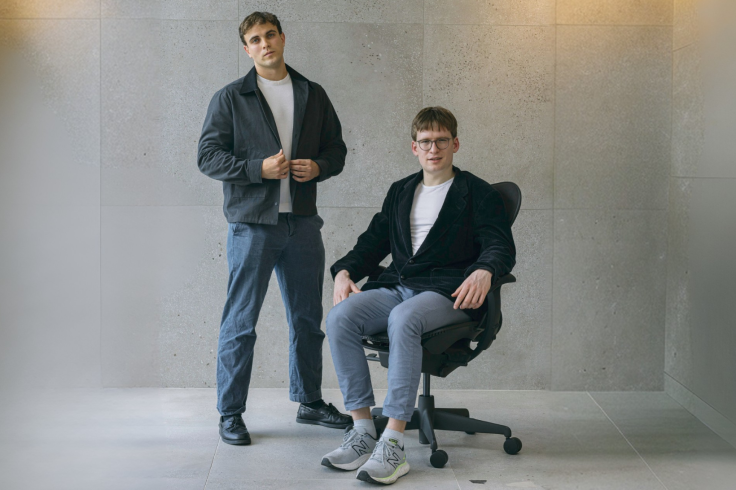How Two Engineers Are Using AI to Make Supply Chains Less Fragile
Inside Rome AI's push to embed real-time adaptability into supply chains—before the next global shock hits.

For much of the last decade, global supply chains were a quiet testament to modern efficiency. Companies had learned to squeeze out waste wherever they could, consolidating suppliers, negotiating leaner contracts, and paring down inventory to free up cash for more productive uses. As long as trade flowed smoothly and demand stayed steady, the model delivered enviable margins.
But that calm has grown harder to maintain.
The pandemic exposed just how few buffers many companies had left. Ports clogged with stranded containers, factories idled for lack of critical parts, store shelves emptied faster than they could be refilled. A prolonged semiconductor shortage forced automakers and electronics firms alike to ration chips, redesign products, and idle entire assembly lines. New tariffs and trade shifts added fresh friction, requiring companies to renegotiate sourcing arrangements and shipping routes with little time to prepare. Layer in more frequent droughts, floods, and severe storms, and even the best-planned network can seize up overnight.
Each new shock has underscored an uncomfortable truth: supply chains built for cost alone can be brittle when the world won't stay still. And when small breakdowns slip through unnoticed, they rarely stay contained for long. A mislabeled shipment, an unfiled customs declaration, a last-minute part substitution - minor mismatches like these have a way of compounding into bigger swings in costs and delivery times, a dynamic planners have long known as the bullwhip effect.
From Rigorous Theory to Real-World Messiness
Few people have studied both sides of this problem - the theory and the daily chaos - as closely as Johannes Herter and Michael Hartmann.
Herter, now Rome AI's head of AI infrastructure, holds multiple degrees from ETH Zurich, where he focused on mathematics, machine learning and complex system design before joining Disney Research Studios and Harvard's Visual Computing Group. His research ranged from generative 3D scene reconstruction to AI models for physical simulations - methods that turned up in places as varied as Disney movies and advanced robotics.
Hartmann, also an ETH-trained computer scientist, spent his early career building large-scale software architectures and leading fast-moving AI projects - from identity systems to AI-driven conversation platforms. A national academic scholar in Germany, he combined hands-on engineering with rigorous theoretical work, eventually co-founding Backyard, an AI-powered video chat startup that sparked thousands of user interactions.
When both joined forces as part of the founding team at Rome AI, now backed by some of Silicon Valley's most seasoned venture investors, they were driven by a simple question: What does it take to keep a supply chain functional when nothing goes to plan?
How AI Can Patch What Planning Misses
At Rome's European office, a glass-and-concrete space tucked just off the university district in Zurich, Herter leads the development of the company's AI infrastructure - the core system that pulls thousands of live signals into a single, coherent view of what's really happening inside a supply chain at any moment. From custom-built dashboards to machine learning models that learn patterns over time, his team's tools compare planned flows with actual movements, supplier updates and customs records minute by minute.
But simply knowing where something has slipped isn't enough. Hartmann, who heads the team that builds Rome's AI 'agents', argues that supply chain resilience depends not just on detection but on speed of resolution.
'Time is the single biggest factor,' Hartmann said. 'If a shipment is late but you catch it and reroute immediately, it's minor. If you miss it, you get a chain reaction - backlogged docks, missed production slots, customers calling support.'
To head off that cascade, Rome's agents handle routine disruptions on the fly. If a storm reroutes a ship, the AI can flag the new arrival port and reassign ground transport before a human has to step in. If a supplier switches to an alternate part at the last minute, the system updates purchase orders and customs declarations automatically. Only the thorny exceptions - cases where there is no obvious right answer - reach planners' desks, and with supporting details laid out in plain language.
A Safety Net for the Unexpected
Herter and Hartmann say they don't pretend Rome's tools can stop the next global shock. No software can prevent a geopolitical standoff or a drought that cripples a key shipping canal. But they argue that catching everyday mismatches quickly - and resolving what can be handled automatically - buys companies precious breathing room to make the more complex decisions that AI can't solve alone.
'Every major disruption forces a rapid reoptimisation of the supply chain under new constraints,' Herter said. 'As a machine learning engineer, I focus on building systems that can reason through uncertainty - AI that not only identifies emerging mismatches in real time, but applies structured models to intervene early, contain cascading effects, and restore coherence before planners ever need to step in. The aim is to embed resilience directly into the infrastructure, so adaptability becomes the default, not the exception'
Their hope is that more companies will start treating resilience not just as a crisis response but as a daily operating standard - a buffer built in advance rather than improvised after the fact.
'You can't stop the big disruption,' Hartmann said. 'But you can stop it from turning into ten new problems. That's the difference between a supply chain that bends and one that breaks.'
As the world continues to face unpredictable disruptions - from geopolitical tensions to climate volatility - the need for intelligent, adaptive infrastructure is only growing. Herter and Hartmann argue that the next wave of innovation won't rely on perfect foresight, but on systems built to adapt in real time. With Rome AI's tools already embedded in some of the world's most complex supply networks, their approach is no longer theoretical - it's proving itself, day after day.
© Copyright IBTimes 2025. All rights reserved.





















